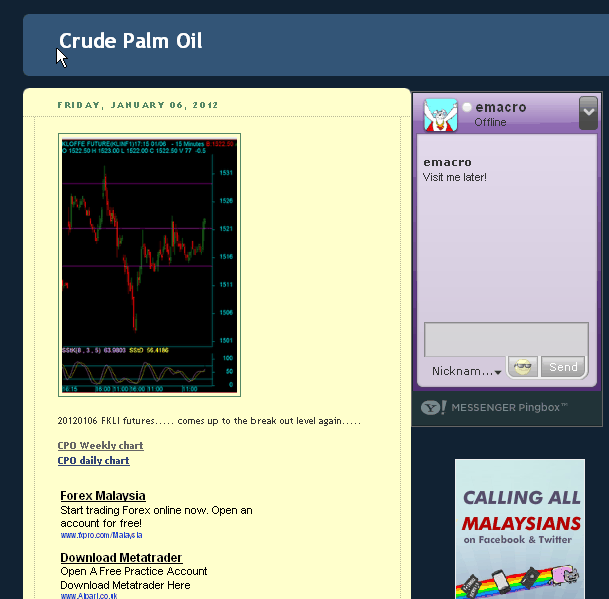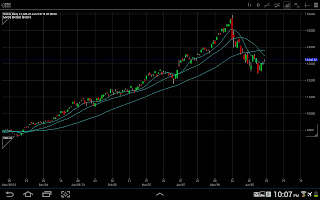FKLI Futures Trading - Bursamalaysia
This will chronicle trading in the FKLI & FCPO futures. If you don't like what you see/read in this blog, just surf away. These opinions are our personal opinions and just a record of our thoughts..."In evolution, it’s not the biggest, the fiercest nor the smartest that survive, it’s the one that changes the fastest.” I.e. the key word is to adapt the trading style to the markets, until it stops working
Saturday, June 29, 2013
Friday, June 28, 2013
Raining premiers slip and slide to a hard-fought Friday night triumph at a waterlogged SCG | AFL | Fox Sports
Thursday, June 27, 2013
Labels: music
Wednesday, June 26, 2013
Tuesday, June 25, 2013
What makes the market move?
The drop in Palm prices was mainly attributed by weakening Indian currency and slowing growth in China which might curb imports by the biggest buyers of the commodity.
In short, if you make money in your trading, stand up and accept the accolades and the financial rewards. But if you lose money, you alone should accept the responsibility. You must have confidence to trade in the marker, because the most serious 'loss' of all is the 'loss' of
confidence in your ability to trade independently and successfully. If you don't have that confidence, you probably shouldn't be making any trades, except to close out adverse positions to limit your loss exposure. The list of speculators' laments goes on, but they all seem generally
related to carelessness or poor trade timing, misjudgement of the market trend, ignorance of the basic tenets of sound strategy, or lack of self-confidence and discipline. Serious introspection suggests this thesis: a sound strategy, viable tactics and good money management, and
consistent risk control are even more important to overall success than a good technical or charting method.
Labels: music
Monday, June 24, 2013
Sunday, June 23, 2013
Labels: music
Bursa: Trades ‘valid and genuine’
When the turtle fish comes out bearing gifts from heaven, one should grab with both hands, feet and mouth.(that's the institutional fellas)
http://biz.thestar.com.my/news/story.asp?file=%2F2013%2F6%2F22%2Fbusiness%2F13274351&sec=business
Saturday, June 22, 2013
Well, the experts have made their prediction, the 10 yr bond yield will go to 3.5 to 4%. Typical of the way the experts think.... Easy la just sell everything including your wife and dog and dog pile into short thr 10 yr bonds. But they never rell you the risk for the stop loss involved in hankering for the potential profit...
Friday, June 21, 2013
Thursday, June 20, 2013
stream
"stupidity got us into this and stupidity will get us out of it" homer Simpson
So k think he qualifies to be the next Fed chairman
Wednesday, June 19, 2013
In The Art of War, Sun Tzu said,
'Greed is a fundamental cause of defeat; it is the unemotional,
reserved, calm detached warrior who wins and not the ambitious
seeker of fortune.'
'Those who are skilled in combat do not become angered, those
who are skilled at winning do not become afraid. Thus the wise
win before they fight, while the ignorant fight to win.'
Tuesday, June 18, 2013
"When I find myself becoming excessively confused or agitated by an excess of such obvious contradictions and contrived after—the-fact announcements and quasi-analysis, my response is to seclude myself from this so-called news. I focus, instead, on a detailed and pragmatic analysis of technical factors and indicators-trying to seek order amongst the chaos. Such an interval is always best conducted in seclusion, away from interruptions and well-intentioned advisors. There seems to be a correlation between the isolation and tranquility of the session and, the clarity and quality of the analysis" Stanley Kroll
Monday, June 17, 2013
Fundamentals v Technical Analysis
The best way to introduce this important subject is with a story — a true one.
Hong Kong Index futures provide excellent trading opportunities and action for speculators. Yet, throughout the three years, from 1991 through 1993, during a period of generally rising stock prices from a world class bull market, where prices rose from approximately 3,000 to over 12,000 (see Figure 4.2), traders continuously probed the short side of this stunning bull market. Every time there was some bearish—sounding news in the press, every time some commentator or interviewee delivered a bearish pronouncement, and especially when any British official talked about Sino-British
disharmony, the market suffered a serious bout of 'bear attack.' In fact, during late 1993, when the Hang Seng was undergoing its most violent and steep upwards move, I watched in amazement as a large office full of traders and account executives peered intently at a small TV monitor listening to a speech by Govemor Chris Patten while the market was open. During the course of the speech, every time the Governor mentioned any aspect of Sino-British problems at the negotiating table, a flood of long liquidation and new short selling engulfed the market. Traders were pparently willing to totally overlook the ongoing trend of the market, which was clearly one way; up. In fact, over the course of several months of an upward trending market, I heard dozens of pronouncements from brokers and traders that they were selling the Hang Seng for a number of diverse reasons.
0 The market looked overpriced'
In reality, the market was in a clear-cut and distinct uptrend and there was no viable, objective reason to play it short.
The absolute need for a disciplined and objective approach to speculation, whether it be in stocks, commoditites or currencies, is a recurring theme of this book. We have all had the experience of relaxing our vigilance, of ignoring the real technical condition and direction of a market, which is generally clear if we are willing to see it. And, the results are uniformly predictable; unsuccessful trading and a string of consistent losses. Unfortunately hope versus fear, impatience, greed and, above all, a lack of discipline, are the major impediments to successful operations.
A parallel situation was experienced in the metals markets commencing around mid-1984. Most of the market projections, economic analyses and brokerage advisories had predicted improving prices and had clearly recommended the long side of the metals markets. Long side indeed! And, here again, the CRB precious metals index tells the same story (see Figure 4.4). Prices poised on the brink "of yet another downleg, soon to be confirmed by actual market action, during the relentless bear markets of the early 1980s. Digesting such a steady stream of bullish pronouncements could hardly fail to give one a bullish bias. However, an objective and pragmatic review of the technical factors clearly showed that we were
on the short side of these rnarkets. entering a bearish scenario. Successful speculators, with a disciplined and pragmatic approach to trend analysis and utilizing a viable trend-following strategy, would have ignored all that market gossip and have focused instead, on a sound technical analysis. In so doing, they would have either scored some good profits on the short side or, at least, have avoided the long side and its attendant trap
In summary, the frequent divergence between what one observes in an objective technical analysis, and what one reads in the so-called news and analysis, seems to provide a near-permanent feeling of ambivalence to many speculators. 'For example, it is generally difficult for the speculator to operate in the currency markets on the basis of fundamental expectations or market gossip. Following weakness in currencies some time ago, the major New York financial papers noted, 'The US dollar surprised traders with a show of strength yesterday that stemmed, in part, from the detention of a Polish labor leader.' The
Deutsch Mark was weak, which was attributed to the fact that German banks are major creditors of Poland. However, the Yen happened to be strong that day, so the same artide deftly labelled its strength as a result of Japan's isolation from Europe. However, had the Yen declined, or had the Deutsch Mark advanced, you can be certain that an appropriately — worded rationale would have been created, and disseminated.
When I find myself becoming excessively confused or agitated by an excess of such obvious contradictions and contrived after—the-fact announcements and quasi-analysis, my response is to seclude myself from this so-called news. I focus, instead, on a detailed and pragmatic analysis of technical factors and indicators-trying to seek order amongst the chaos. Such an interval is always best conducted in seclusion, away from interruptions and well-intentioned advisors. There seems to be a correlation between the isolation and tranquility of the session and, the clarity and quality of the analysis.
"There is the plain fool who does the wrong thing at all times anywhere, but there is the Wall Street fool who thinks he must trade all the time."J Livermore

From Dragons and Bulls by Stanley Kroll
Introduction and Foreword
The Importance of an Investment Strategy
5 The Art of War, by Sun Tau (circa 506 BC) and The Art of Trading Success (circa AD 1994)
That's the way you want to bet
Long-term v Short term trading
Technicals v Fundamentals
Perception v Reality
Part 1: Winners and Losers
Part 2: Winners and Losers
Sun Tzu: The Art of War
Those who tell don't know, those who know don't tell
Why there is no such thing as a "bad market"
The Secret to Trading Success
The Experts, do they know better?
Risk control and money management
Larry Hite: The Billion Dollar fund Manager
Systems Trading:Kroll's Suggested Method
Buy the Strength Sell the Weakness
Good advice
The 'good bets' business by Larry Hite
Don't lose your shirt
Ed Sykota's secret trend trading system













































